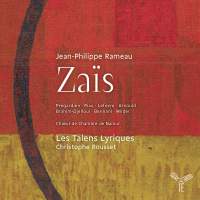Texte paru dans: / Appeared in: |
|
| Recommended |
Outil de traduction ~ (Très approximatif) |
|
Reviewer: Barry
Brenesal Back in 2011 I wrote a review of dance suites from Zaïs and Hippolyte et Aricie as performed by L’Orfeo Baroque Orchestra with Michi Gaigg, conducting (Fanfare 35:2). The gist of it was that the suites were very welcome and extremely well performed, leading to a hope that we would someday see the entirety of Zaïs return to the catalog. The full work wasn’t to be recorded until three years later, as it turns out, and not by Gaigg, but by Christophe Rousset and Les Talens Lyriques. Zaïs was premiered in 1748 during one of Rameau’s most active periods, at a time when he wrote 10 operas in five years. The published score of the day referred to it as a ballet héroïque, but Cuthbert Girdelstone in his Jean-Philippe Rameau, His Life and Work, preferred the term pastorale héroïque. The work is both, an opera in a pastoral setting with very strong balletic elements, whose personalities include both humans and spirits gifted with wondrous abilities. Girdlestone frankly disliked its mix of genies, sylphs, shepherds and magic palaces, very popular at the time—though as he admitted about the work’s creators with evident exasperation, “Cahusac has brought in his usual prescription of féerie and pastorale, and [Rameau’s] inspiration has been best stimulated by these drugs.” Mind, that didn’t prevent Girdlestone from placing Zaïs in his chapter entitled “Minor Works.” He does give it high marks for its many dances, and excepts one piece from his comment that “the vocal numbers are less arresting.” It’s Zélidie’s act III air, “Coulez mes pleurs,” of which the usually moderate author writes, “Did one evaluate music by the unit I would say that these bars were the most precious in all Rameau.” Strong words, indeed. So why nothing else? At the risk of offending Girdlestone’s shade, I think he may have been reacting to a serious weakness caused by the opera’s plot. The eponymous hero is steadfast in his belief in Zélidie’s love. His friend Cindor doubts her character’s strength, but his role in the opera is ultimately to illuminate, as part of Cupid’s test of the young human shepherdess—not to taint or defraud; this isn’t The Two Gentlemen of Verona. This means that the expressive range of two out of three of the main characters is heavily circumscribed from the beginning of the work. Many of Rameau’s operatic people come to life through a combination of literary and music strengths, but not here. That doesn’t prevent Rameau from furnishing several excellent airs, however. Girdlestone is right in singling out the technical ingenuity and expressive character of “Coulez mes pleurs,” but there are several others just as good in their own way. Thus the female sylph’s air in the prelude, “Chantez, oiseaux, chantez,” demonstrates an instrumental weave of great delicacy and inventiveness in its accompaniment. Zaïs gets three gems: “Connais mieux les douceurs,” an excellent example of heightened recitative with an experimental da capo structure; his act II “Vole, enchante mon cœur,” an air of majestic emotional certainty and affection; and act IV’s “Règne Amour,” a piece with a fine folk quality that spotlights the violin. Cindor in turn leads an air and chorus in act II, “Zéphyrs, calmez la terre,” a piece of haunting melancholy that reflects joy in the evanescent beauty and calmness of the world following a terrible storm. The only previous complete recording of Zaïs has been out of active hard copy circulation for some time. A new version is thus welcome, especially when performed with the sense of style and flair that Rousset and his forces bring to their task. Of the three leads, Sandrine Piau’s vocal estate is best: a meltingly lyrical lyric soprano with great tonal control, fine handling of figures, and perfectly even production. Tenor Julian Prégardien has a bit of trouble moving his voice over the faster figurations of “Règne Amour,” but manages his ornaments with ease, and sings everywhere with good breath control, enunciation, and interpretative intelligence. As much can be said of Benoít Arnould. His Tancréde in Campra’s opera of the same name pushed his voice too often off-center in a curious pursuit of emotional power, but here he’s fairly well back in form. Like Prégardien he manages passages requiring great vocal agility with a bit of lumbering about, but is otherwise more than capable of doing justice to his role. The smaller parts demonstrate great casting strength. Amel Brahim-Djelloul, whom I greatly enjoyed in Rameau’s Les surprises de l’Amour (Glossa 922701), stands out once again “not only for tonal beauty and phrasing, but for an extremely forward enunciation that surpasses her colleagues.” Hasnaa Bennani’s Amour phrases flexibly, persuasively, Aimery Lefèvre is a suave Oromazès if not an especially rich-voiced one, and Zachary Wilder delivers the only wildly bravura piece in the opera, “Dans nos feux,” with jaw-dropping ease. Rousset leads the voices and instruments of Les Talens Lyriques with an expert hand. He shorts nothing, not the recitatives, airs, choruses, preludes and especially the work’s many varied dances, which are almost worth the price of the set alone.
To Girdlestone’s credit he
recognized his prejudice against the opera’s subject matter. He ended his
brief survey of the opera by quoting Paul-Marie Masson, author of “L’opéra
de Rameau,” to the effect that “It is this mixture of the grand, the
graceful, and the touching … which gives Zaïs its special charm.” I second
that. Cahusac’s libretto has its silly elements, but all is redeemed in
Rameau’s genius. Recommended. | |
|
|
|
|
Cliquez l'un ou l'autre
bouton pour découvrir bien d'autres critiques de CD |
|




